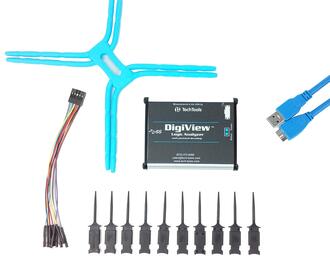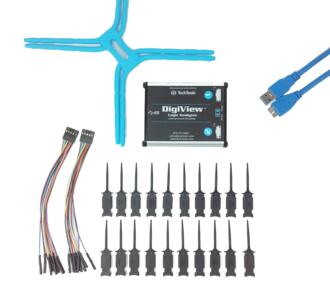DigiView™ Compression
This page explains the benefits of DigiView's compression and provides an interactive chart so you can see the actual improvements for a variety of data formats.Note that you do NOT have to read or understand this page to get the benefits. It is always enabled and requires no configuration. It 'just works.' You can skip the explanation and jump to the Results
The Ideals
Two important features we want in a logic analyzer are long capture times and high sample rates.Long Capture Time
The desire for a long capture time is pretty intuitive. Advantages of longer captures:- Better chance of capturing elusive problems
- More context around the problem
- Capture longer sequences
- Capture more sequence instances for comparison
High Sample Rate
Increased sample rates result in higher resolution captures, which reduces the edge uncertainty. This:- Increases the maximum data rate we can capture
- Improves the waveform fidelity
- Improves measurement accuracy
- Improves ability to resolve setup and hold times.
- Improves ability to extract/decode protocols.
The Problem - Conflicting Goals
The minimum acceptable sample-rate is often much higher than people assume. It is very subjective, but is driven by the maximum acceptable distortion or edge uncertainty. If you are interested in measuring pulse widths, the over-sample rate (pulse-width/sample-period) determines the pulse distortion and measurement error. Obviously an over-sample rate <= 1 results in missing pulses and generally garbage data. An over-sample rate of 10x still results in a 10% uncertainty in the measurements (and display). So the sample-rate must be faster (and usually much faster) than the data rate.
Even with relatively slow signals, you might need a high sample rate to measure the skew or setup/hold times between signals. Again, the over-sample rate (skew/sample-period) will determine the accuracy of these measurements. The sample-period must be less than the setup/hold times to ensure you can even tell which signal preceded the other.
Often, when you use the minimally acceptable sample-rate, you find that the capture time is still unacceptably short.
If not for the capture time compromises, we would always use the highest possible sample rate.
The Solution - Compression
As you would expect, compression increases the number of samples stored in a given amount of memory, thereby increasing the capture time. Less obvious is the fact that it also allows for improved resolution and all of its benefits.
DigiView's hardware-based compression automatically optimizes both capture time and resolution. It gives you the longest possible capture times by storing compressed samples at the DATA-rate (1 sample per transition.) Note that a traditional logic analyzer must store several samples per transition (over-sampling) to achieve any kind of acceptable distortion levels.
At the same time, it gives you the highest possible resolution by always sampling at its maximum sample rate. This does not fill up the storage because the compressor removes the redundant samples.
Best of all, this is fully automatic. It does not require any user settings or need any advanced knowledge of the data format. The compressor adapts to the data characteristics in real-time, providing optimized results even with highly variable data rates (like bursts or low duty cycle signals.)
You always get the best possible resolution and the longest possible capture.
The Results
See for yourself. The following interactive chart lets you specify different data patterns and then compare DigiView's compressed sampling with that of a traditional logic analyzer.
Set the Pulse Width and Duty Cycle to emulate your data. Then adjust the sample rate and observe how the two approaches compare in the 'Results' chart. We also show the distortion effects of the sample rate in the graphic at the top of the 'Configuration' chart.
To ensure apples-to-apples comparisons, we assume the same storage and maximum sample rates for both units and set the minimum pulse width to a reasonable value for the maximum sample rate.
| Configuration | |
| ? Distortion/Resolution:
| |
| ? The signal pulse width and duty cycle settings let you evaluate a clock or pulse train input. This is a simple data pattern but sufficient to demonstrate DigiView's capture time and resolution advantages. | 10ns |
20% (50ns) | |
| ? DigiView Mode Choose DigiView Mode:
| |
| ? Choose traditional logic analyzer sample rate for comparison. NOTE: this is NOT the DigiView sample rate; DigiVIew always samples at its maximum. | Sample Rate: 1 Gsps |
| Results | ||
| DigiView Advantage 10x Capture Time at 10x Resolution | ||
| (smaller is better) | DigiView | Traditional |
| ? Resolution 1 / Sample-rate | 1ns | 10ns |
| ? Distortion 100 * Resolution / Pulse-width | 1% | 10% |
? Storage Used per Cycle Number of storage locations used to store 1 cycle. Lower numbers imply better storage utilization / longer captures. DigiView: 1 per transition Traditional: Sample-rate * Cycle-period | 2 | 20 |
Note: If you set the traditional sample rate equal to DigiView's, DigiView will always store more data. Conversely, if you try to reduce the sample rate enough to match DigiView's capture time, you will hit 100% distortion before you get there. So even with the traditional unit set to its lowest usable sample rate, DigiView will still store more time, and with much less distortion.
You ALWAYS get better results with DigiView™
Need more information?
Browse the left-hand menu, or choose one of of these shortcuts:Ready to hunt down bugs?
Choose your debug partner.
DV509

500Msps@9ch
100M Transitions, > 1B samples
4M-18M Protocol Characters/Bytes
$599
DV518

250Msps@18ch
100M Transitions, > 1B samples
4M-18M Protocol Characters/Bytes
$749
All DigiViews include: • All available Protocol Plugins • USB and Data Cables • Full compliment of Micro-grabber clips • Plugin Developers' Kit • Free lifetime software updates and support
1 Try our interactive chart for more capture details.